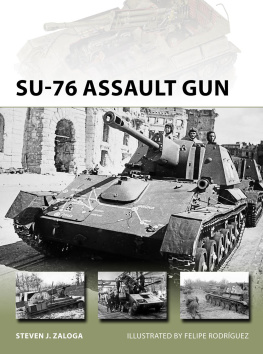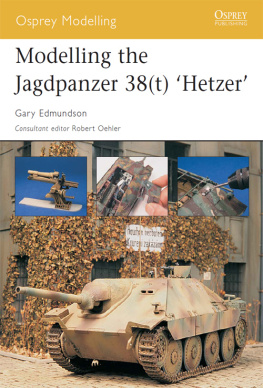
IMAGES OF WAR
HITLERS TANK DESTROYERS 1940-45
RARE PHOTOGRAPHS FROM WARTIME ARCHIVES
Paul Thomas
First published in Great Britain in 2017 by
PEN & SWORD MILITARY
An imprint of
Pen & Sword Books Ltd
47 Church Street
Barnsley
South Yorkshire
S70 2AS
Copyright Paul Thomas, 2017
ISBN 978-1-47389-617-8
eISBN 978-1-47389-619-2
Mobi ISBN 978-1-47389-618-5
The right of Paul Thomas to be identified as author of this work has been asserted by him in accordance with the Copyright, Designs and Patents Act 1988.
A CIP catalogue record for this book is available from the British Library.
All rights reserved. No part of this book may be reproduced or transmitted in any form or by any means, electronic or mechanical including photocopying, recording or by any information storage and retrieval system, without permission from the Publisher in writing.
Pen & Sword Books Limited incorporates the imprints of Atlas, Archaeology, Aviation, Discovery, Family History, Fiction, History, Maritime, Military, Military Classics, Politics, Select, Transport, True Crime, Air World, Frontline Publishing, Leo Cooper, Remember When, Seaforth Publishing, The Praetorian Press, Wharncliffe Local History, Wharncliffe Transport, Wharncliffe True Crime and White Owl.
For a complete list of Pen & Sword titles please contact
PEN & SWORD BOOKS LIMITED
47 Church Street, Barnsley, South Yorkshire S70 2AS, England
E-mail:
Website: www.pen-and-sword.co.uk
Introduction
T his book of rare and unpublished photographs is dedicated to German anti-tank and mobile artillery vehicles of the Second World War. With detailed captions and text the book describes how these assault and self-propelled guns made their first major appearance on the battlefield. Some were little more than stopgap solutions, mounting an artillery or anti-tank gun on a tracked vehicle to give mobility, while others were more sophisticated designs. The book shows the development and technology throughout the war that led to self-propelled artillery and tank destroyers like the Panzerjger I, Marder, Wespe, Nashorn, Hetzer, Jagdpanzer, Elefant, Jagdtiger IV and Jagdpanther vehicles being developed. At the beginning of the war some of these tanks were basically an anti-tank gun on tracks, but as the war progressed their fire power became more lethal to defend the ever increasing threat against Soviet armour. Larger and more powerful tank destroyers entered the battlefield, but due to the overwhelming enemy opposition the tank destroyers were compelled not only to attack armour, but to support ground troops too. This led to massive losses where the tank destroyers were never to recover.
The history of Hitlers tank destroyers is a compelling account of the men and machines that fought and defended its way across Europe and Russia. The book is undoubtedly a good addition to war gamers, model makers, and all interested in armour of the Second World War.
Chapter One
Panzerjager I, Marder and Sturmpanzer I (19401942)
F or the invasion of Poland the need for any type of anti-tank vehicle was unnecessary due to the overwhelming superiority of German armour and the lack of enemy tank power. However, it was realized during the Polish campaign that the towed sIG 33 guns assigned to the infantry gun companies of the motorized infantry regiments had reported difficulties keeping up with the tanks during combat. This left some infantry exposed on the battlefield so to remedy this the Germans decided to modify a spare tank chassis to carry it into battle instead. A sIG 33 was mounted on the chassis of the Panzer I Ausf. B, complete with carriage and wheels, in place of the turret and superstructure. A thick tall, open-topped fighting compartment on the forward part of the hull was bolted in place. Thirty-six of these artillery vehicles were organized into independent schwere Infanteriegeschtz-Kompanie (self-propelled heavy infantry gun companies) and were assigned to the Panzer divisions in France in 1940. The vehicles were known as the 15cm sIG 33 (Sf) auf Panzerkampfwagen I Ausf. B or better known as the Sturmpanzer I or Bison.
Alongside these self-propelled heavy infantry guns, a new tank hunter or Panzerjger made its debut at the same time. As with the sIG 33 howitzer the Germans knew that their 3.7cm PaK 35/36 anti-tank gun was beyond the capabilities of some of the French tanks like the Char B1. Consequently, the first anti-tank destroyer to see action was introduced on to the battlefield. The vehicle mounted a Czech koda 4.7cm (1.9in) PaK(t) anti-tank gun (4.7cm PaK(t) (Sf) auf Panzerkampfwagen I ohne Turm) which was on a converted Ausf. B chassis. anti-tank gun and served to extend the life of the obsolete Panzer I tank chassis. Even by 1940 it was realised that the Pz.Kpfw.I was obsolete as a battle tank, and between 1940 and 1941 these tanks were converted to what was known as a Panzerjager I. In total some 200 of these converted tank hunters were adapted.
Building the tank hunter was relatively straightforward. The hull was almost unchanged, with the turret and ring removed. A five-sided open-toped gun shield was bolted to the chassis to protect the main armament and the crew, and the antitank gun was fixed on a platform in a fighting compartment. The vehicle was capable of carrying seventy-four anti-tank 10 HE shells. Production was assumed by Alkett, which built the first batches of 142 in 1940, whilst the remainder were assembled by Klckner-Humboldt-Deutz in 1940 and 1941.
The tank hunter retained its small Maybach NL 38 TR Engine that was capable of propelling it at speeds of up to 40km/h. It had a crew of four and there was no defensive weapon to protect itself from local enemy fire.
The vehicle weighed around 6,400kg and a total length of about 4.4m. Armour protection was limited with a total thickness of 14mm on its frontal shield. It had a 5-speed forward, 1-speed reverse transmission and a leaf spring suspension system. Reliability in all conditions was regarded fairly good and combat effectiveness was unusually high despite the fact that its main gun was very bad at dealing with more heavily armoured vehicles. Since it was used mainly in France and the early phase of the Russian campaign, most of the early tanks it encountered were only lightly armoured and it was able to deal with this threat.
On the battlefield the Panzerjger I was generally organized into nine-vehicle companies, with three companies per battalion. During the French Campaign anti-tank battalion Panzerjger-Abteilung.521 had only six vehicles per company, but was also used by independent anti-tank battalions. In total five Panzerjger companies were equipped with a 4.7cm PaK auf Pz.Kpfw.I. In France this vehicle provided ample mobile anti-tank support for the infantry divisions. Throughout the Western campaign the Panzerjger fought with distinction, and supported the infantry extensively throughout with little hindrance to the fast moving mobile operations.
By the end of the campaign it was recognized that the anti-tank hunter would become an integral part of the armour used on the battlefield to assist in the penetration of enemy positions and support the infantry in a number of offensive roles against enemy tanks.
In the Balkan Campaign in 1941 the Panzerjger I once again saw action, with one company being assigned to the SS-Brigade Leibstandarte der SS Adolf Hitler and another to Panzerjger-Abteilung 900 of Lehr-Brigade (mot.) 900 (900th Motorized Training Brigade) in preparation for the invasion of Russia.
Next page


















